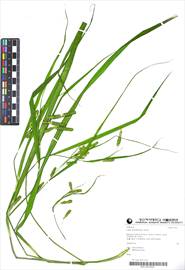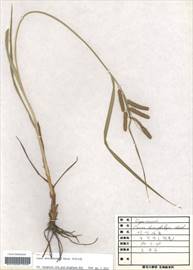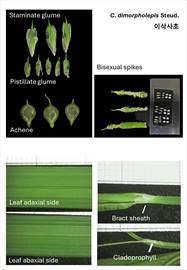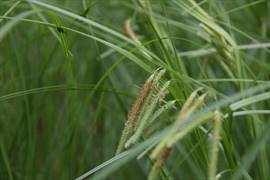Scientific Name
Carex dimorpholepis Steud.
Subgeneric Classification (Roalson et al. 2021)
| subgenus Carex; Hirta-Praelongae Clade; Praelongae section |
Habitats
Occurs in Gangwon, Seoul, Gyeonggi, Chungbuk, Chungnam, Gyeongbuk, Gyeongnam, Jeonbuk, Jeonnam or Jeju.
Stem
Clumped growth, with basal sheath color dark brown to reddish brown, and length about 35-80 cm.
Leaves
Leaves longer than the stem or similar to the stem, have glabrous surfaces, width about 4-7 mm.
Inflorescence
The number of spikes two or more. Spike shapes all same (no distinct differentiation between sexual characteristics) or different (showing distinct sexual characteristics), with some spikes bisexual, spikes arranged loosely. Terminal spike sexuality gynecandrous or androgynous. Lateral spike sexuality pistillate, gynecandrous or androgynous, and drooping. Lateral spike length about 4.5-5.5 cm. Terminal spike length about 4-6 cm. Number of spikes per node one (one spike in one bract).
Bract
Lowermost bract shape leaf-like.
Glume
Staminate glume awn long (awn more than one-third of the total length). Pistillate glume awn long (awn more than one-third of the total length). Pistillate glume color whitish green to light brown.
Perigynium
Transverse section lenticular to biconvex. Perigynium shape elliptical to narrow elliptical (the broadest part in the center), and densely flowered. Perigynium glabrous. Beak short (beak less than one-third of the total length), with truncate mouth. Length 3 mm.
Achene
Appendage absent, no constrictions.
Copyright © 2024. All rights reserved.




